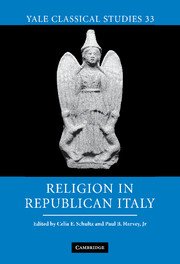Book contents
- Frontmatter
- Contents
- List of illustrations
- List of contributors
- Acknowledgments
- List of abbreviations
- Introduction
- Chapter 1 Reconsidering “religious Romanization”
- Chapter 2 In search of the Etruscan priestess: a re-examination of the hatrencu
- Chapter 3 Etruscan religion at the watershed: before and after the fourth century bce
- Chapter 4 Religious locales in the territory of Minturnae: aspects of Romanization
- Chapter 5 Religion and memory at Pisaurum
- Chapter 6 Inventing the sortilegus: lot divination and cultural identity in Italy, Rome, and the provinces
- Chapter 7 Hot, cold, or smelly: the power of sacred water in Roman religion, 400–100 bce
- Chapter 8 Religion and politics: did the Romans scruple about the placement of their temples?
- Chapter 9 Juno Sospita and Roman insecurity in the Social War
- Chapter 10 Beyond Rome and Latium: Roman religion in the age of Augustus
- Bibliography
- Index
Chapter 2 - In search of the Etruscan priestess: a re-examination of the hatrencu
Published online by Cambridge University Press: 08 January 2010
- Frontmatter
- Contents
- List of illustrations
- List of contributors
- Acknowledgments
- List of abbreviations
- Introduction
- Chapter 1 Reconsidering “religious Romanization”
- Chapter 2 In search of the Etruscan priestess: a re-examination of the hatrencu
- Chapter 3 Etruscan religion at the watershed: before and after the fourth century bce
- Chapter 4 Religious locales in the territory of Minturnae: aspects of Romanization
- Chapter 5 Religion and memory at Pisaurum
- Chapter 6 Inventing the sortilegus: lot divination and cultural identity in Italy, Rome, and the provinces
- Chapter 7 Hot, cold, or smelly: the power of sacred water in Roman religion, 400–100 bce
- Chapter 8 Religion and politics: did the Romans scruple about the placement of their temples?
- Chapter 9 Juno Sospita and Roman insecurity in the Social War
- Chapter 10 Beyond Rome and Latium: Roman religion in the age of Augustus
- Bibliography
- Index
Summary
Ancient and modern sources alike stress the Etruscan devotion to, and talent for, conducting religious rituals, particularly those involving divination, and the prominent public roles enjoyed by Etruscan women. Yet these two distinct, cultural features never appear to overlap; we have no substantial evidence at present for official Etruscan female religious activity. Both the material and textual records are curiously reticent on this topic, offering only obscure hints and tantalizing possibilities. One case alone stands as possible proof of Etruscan priestesses: several late fourth-/early third-century bce funerary inscriptions from Vulci identify twelve women from a number of elite families as hatrencu. The term has been tentatively defined and accepted as a religious title, in turn linked, on the basis of Greek and Roman parallels, to an all-female religious association devoted to a deity who presided over traditionally feminine concerns.
The evidence concerning the term hatrencu, however, combined with new research on women in early Roman religion and new comparanda from further afield, strongly suggests that we should not assume that the term refers to a religious position, let alone that of a specifically female office. Instead, we find a broader range of possible interpretations, most significantly that hatrencu may in fact be a civic title. This finding highlights the hatrencu as an extremely localized phenomenon, particular to Vulci and comparable to the female magistrates found in Roman Asia Minor.
ETRUSCAN WOMEN AND RELIGION
The famed Etruscan queen Tanaquil stands as the most vivid image we have of an Etruscan woman.
- Type
- Chapter
- Information
- Religion in Republican Italy , pp. 34 - 61Publisher: Cambridge University PressPrint publication year: 2006
- 3
- Cited by



